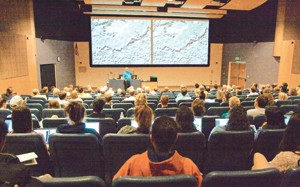Peter Smith, the principal investigator of the Phoenix Mars Mission, related the findings of the latest scientific inquiry into our neighboring planet during his first campus lecture of the year Tuesday night, which was attended by students, astronomy enthusiasts and members of the Tucson community.
Smith began his one-hour presentation about the mission with an overview on human’s cultural understanding of Mars.
“”Mars was first seen as a dot in the sky,”” he said. “”Nobody knew it was a world. It was not known to be a planet like Earth.””
Space has always captivated humanity’s imagination. It was not long ago that that fiery foreign object in the night sky became known to humanity as the God of War because of its bright red color, Smith said.
And soon after that, when people discovered that Mars was a planet, humans again found themselves enthralled by the mysteries that it could hold. They conjured up stories about what might exist on that small orb that was still just a speck, but a potentially dangerous alien world, Smith added.
“”We had all kinds of wonderful stories about the inhabitance of our neighboring planet,”” Smith said, drawing from his boyhood and the fantastical space tales he read. “”Once you think in your head that the neighboring planet has intelligent life . . . it doesn’t take too long before you wonder maybe they’re not too friendly and want to come down and attack you.
“”The truth is,”” Smith continued, “”it’s the other way around, and we’re headed towards Mars.””
On May 25, 2008, the Phoenix Lander touched down on the arctic plains of Mars with on-board instruments designed and tested at the UA by Smith and his team of researchers.
The Phoenix’s mission: find life. The theme: fire and water.
“”Fire and water have come to signify our mission,”” Smith said, pointing out that the mission’s logo encompasses both themes in the fiery Phoenix bird conjoining with a water droplet.
“”When we get to Mars, we bring water with us and we mix it with the soil,”” he said.
Ice layers lie a few inches under the Martian surface, reports Smith. However, when Mars was a developing planet, the climate was likely warmer.
“”In the past, maybe (500,000 to 1 million) years ago, the ice might have been liquid,”” Smith said. “”We recreate that state by mixing the water with the soil and look to see what goes into solution. Water and fire is where we cook some of this soil and drive off vapors.””
Thus far, no life has been discovered, but Smith remains hopeful. He believes that the icy layers beneath the surface may be the key to unlocking the mystery of whether or not life ever existed on Mars.
The mission will likely end in November or early December, when the lander will be overtaken by the harsh winter temperatures of the planet.
“”We’ll be trying our best to get the last drops of science out of this mission until then,”” Smith said.
In its final days, Phoenix will continue to analyze the soil but will also collect the first-ever weather data from the polar region during the onset of winter.









